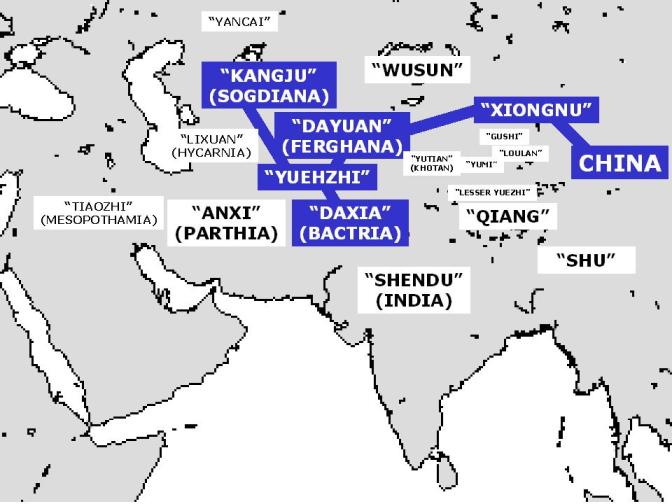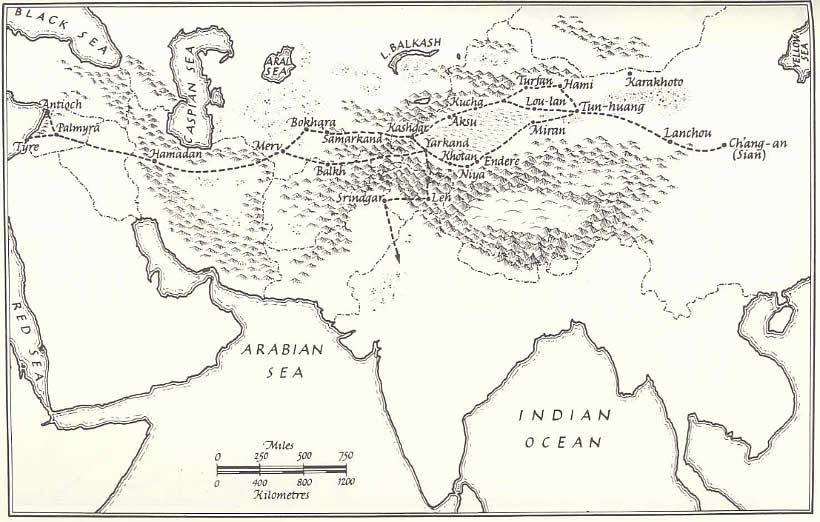Post by humgujjar on Dec 2, 2014 15:27:12 GMT 5.5
Zhang Qian and The Yuezhis (Gujjars)
The Departure of Zhang Qian
In the year 138 BC, the Han emperor Wu decided to form an alliance with the Yuezhi kingdom against the Xiongnu kingdom (an enemy to the Han kingdom). However, sending a message from the Han kingdom to the Yuezhi kingdom meant that one had to travel through the enemy Xiongnu kingdom. To accomplish this, ninety-nine experienced military officers were chosen (which included Zhang Qian) that were supposed to safely pass through the Xiongnu kingdom, reach the Yuezhi emperor and deliver the message of the Emperor Wu.
The following image shows Zhang Qian's travel route (the blue boxes represent the places which Zhang Qian visited himself, while the white boxes represent the places which he learned from others):
The Return of Zhang Qian
Zhang Qian returned back to the Han kingdom around 125 BC, and out of the ninety-nine officers he was the only one who survived the mission. He was unsuccessful in forming an alliance with the Yuezhi, as they were unwilling to risk their settlements, however, he did manage to acquire critical information for the Han emperor. Zhang Qian wrote detailed descriptions of the kingdoms he visited and learned about, the following are the descriptions of the three kingdoms relevant to our topic as written by him:
The Silk Road
Here is an image showing the popular kingdoms which existed on the ancient Silk Road (Pay special attention to the mountains on the map, it is really hard to travel through these mountains even today, and no one in India except the Gujjars travel on these mountains, even today. In fact, he Pahari language is actually the Gujjri language):
My Conclusions
From the descriptions of these kingdoms by Zhang Qian, it seems that Sindhu and Bactria had similar culture in 200 BC, which must mean that these lands must have had a strong connection with each other. Zhang Qian also mentioned that Bactria was overpowered by the Yuezhis, and the most significant clan of the Yuezhi confederation was the Kushan. I have already discussed that the Kushans were either originally Indians or included a strong Indian element as is apparent from their language and religion.
The modern historians like to set Pakistan as the upper-most northern border of ancient India, even though some prominent historians have also included Afghanistan in ancient India, the majority of them will never define any part of Central-Asia as part of ancient India, which is nothing but political bias.
The following image shows the extent to which Budhism was spread under Ashoka The Great (260 BC):
The Relation Between the Words Kooch, Göçer, and Gujjar
The words Kooch (to migrate, or roam), Göçer (Nomad, and a tribal designation in Turkmenistan, Iran, Azerbaijan and Turkey) and Gujjar (a tribal designation of Indian warrior nomads) are related to each other. The Gujjars were ancient nomad-warriors of India who were so wide-spread and far-travelled that even today the word Gujjar is used by people of far away lands to refer to a nomad. In fact, the word "kooch" is derived from the word Gujjar (Koochar) as well.
Dr Javaid Rahi is of the opinion that Gujjars originate from the Turkmen Göçers who are part of the Oghuz Turk nomads. I dont disagree with him identifying the Gujjars with the Göçers but I do disagree with him originating the Gujjars from the Turkish people. The Gujjars definitely have strong Turkish, Persian, and Central-Asian elements, but they did not originate from Turkey. They originate from the Aryas, who were primarily a cattle raising nomadic group of people.
The Departure of Zhang Qian
In the year 138 BC, the Han emperor Wu decided to form an alliance with the Yuezhi kingdom against the Xiongnu kingdom (an enemy to the Han kingdom). However, sending a message from the Han kingdom to the Yuezhi kingdom meant that one had to travel through the enemy Xiongnu kingdom. To accomplish this, ninety-nine experienced military officers were chosen (which included Zhang Qian) that were supposed to safely pass through the Xiongnu kingdom, reach the Yuezhi emperor and deliver the message of the Emperor Wu.
The following image shows Zhang Qian's travel route (the blue boxes represent the places which Zhang Qian visited himself, while the white boxes represent the places which he learned from others):
The Return of Zhang Qian
Zhang Qian returned back to the Han kingdom around 125 BC, and out of the ninety-nine officers he was the only one who survived the mission. He was unsuccessful in forming an alliance with the Yuezhi, as they were unwilling to risk their settlements, however, he did manage to acquire critical information for the Han emperor. Zhang Qian wrote detailed descriptions of the kingdoms he visited and learned about, the following are the descriptions of the three kingdoms relevant to our topic as written by him:
The Yuezhi Kingdom
After obtaining the help of the king of Dayuan, Zhang Qian went southwest to the territory of the Yuezhi, with whom he was supposed to obtain a military alliance against the Xiongnu.
"The Great Yuezhi live some 2,000 or 3,000 li (1,000 or 1,500 kilometers) west of Dayuan, north of the Gui (Oxus) river. They are bordered to the south by Daxia (Bactria), on the west by Anxi, and on the north by Kangju (康居). They are a nation of nomads, moving place to place with their herds and their customs are like those of the Xiongnu. They have some 100,000 or 200,000 archer warriors." (adapted from Shiji, 123, Zhang Qian quote, trans. Burton Watson).
Zhang Qian also describes the origins of the Yuezhi, explaining they came from the eastern part of the Tarim Basin, a momentous explanation which has encouraged historians to connect them to the Caucasoid mummies, as well as to the Indo-European-speaking Tocharians that have been identified from precisely the same area:
"The Yuezhi originally lived in the area between the Qilian or Heavenly Mountains (Tian Shan) and Dunhuang, but after they were defeated by the Xiongnu they moved far away to the west, beyond Dayuan (Ferghana), where they attacked the people of Daxia (Bactria) and set up the court of their king on the northern bank of the Gui (Oxus) river." (Shiji, 123, Zhang Qian quote, trans. Burton Watson).
A smaller group of Yuezhi, the "Little Yuezhi", were not able to follow the exodus and reportedly found refuge among the "Qiang barbarians".
The Daxia Kingdom (Bactria)
Zhang Qian probably witnessed the last period of the Greco-Bactrian Kingdom, as it was being subjugated by the nomadic Yuezhi. Only small powerless chiefs remained, who were apparently vassals to the Yuezhi horde. Their civilization was urban, almost identical to the civilizations of Anxi and Dayuan, and the population was numerous.
"Daxia is situated over 2,000 li (1,000 kilometers) southwest of Dayuan (Ferghana), south of the Gui (Oxus) river. Its people cultivate the land, and have cities and houses. Their customs are like those of Dayuan. It has no great ruler but only a number of petty chiefs ruling the various cities. The people are poor in the use of arms and afraid of battle, but they are clever at commerce. After the Great Yuezhi moved west and attacked and conquered Daxia, the entire country came under their sway. The population of the country is large, numbering some 1,000,000 or more persons. The capital is Lanshi (Bactra) where all sorts of goods are bought and sold." (Shiji, 123, Zhang Qian quote, translation Burton Watson).
The Shendu Kingdom (Pakistan)
Zhang Qian also reports about the existence of Pakistan southeast of Bactria. The name Shendu (身毒) comes from the Sanskrit word "Sindhu", meaning the Indus river of Pakistan. Sindh was one of the richest regions of India at the time, ruled by Indo-Greek Kingdoms, which explains the reported cultural similarity between Bactria and India:
"Southeast of Daxia is the kingdom of Shendu (Sindh, Pakistan)... Shendu, they told me, lies several thousand li southeast of Daxia (Bactria). The people cultivate the land and live much like the people of Daxia. The region is said to be hot and damp. The inhabitants ride elephants when they go in battle. The kingdom is situated on a great river (Indus)" (Shiji, 123, Zhang Qian quote, trans. Burton Watson).
The Silk Road
Here is an image showing the popular kingdoms which existed on the ancient Silk Road (Pay special attention to the mountains on the map, it is really hard to travel through these mountains even today, and no one in India except the Gujjars travel on these mountains, even today. In fact, he Pahari language is actually the Gujjri language):
My Conclusions
From the descriptions of these kingdoms by Zhang Qian, it seems that Sindhu and Bactria had similar culture in 200 BC, which must mean that these lands must have had a strong connection with each other. Zhang Qian also mentioned that Bactria was overpowered by the Yuezhis, and the most significant clan of the Yuezhi confederation was the Kushan. I have already discussed that the Kushans were either originally Indians or included a strong Indian element as is apparent from their language and religion.
The modern historians like to set Pakistan as the upper-most northern border of ancient India, even though some prominent historians have also included Afghanistan in ancient India, the majority of them will never define any part of Central-Asia as part of ancient India, which is nothing but political bias.
The following image shows the extent to which Budhism was spread under Ashoka The Great (260 BC):
Now looking at the above image and then saying that Indians "never" spread north than Pakistan or Afghanistan is just political bias and nothing else. And this is only 200 BC, if we go further back to the migrations of the Aryas, then pretty much whole of Asia and Europe was linked with ancient India. For starters, Iran, and Armenia are named after Aryas! Without getting into the debate of whether Aryas were Indian or not, one has to accept the fact that they were great "connectors" between people who are now considered "unconnected". And Aryas were Indians, the Aryan invasion is another myth spread by the European historians due to political bias towards India and Indians. And remember there is no race called "Indians", India is a racially diverse land from the very ancient times.
The Relation Between the Words Kooch, Göçer, and Gujjar
The words Kooch (to migrate, or roam), Göçer (Nomad, and a tribal designation in Turkmenistan, Iran, Azerbaijan and Turkey) and Gujjar (a tribal designation of Indian warrior nomads) are related to each other. The Gujjars were ancient nomad-warriors of India who were so wide-spread and far-travelled that even today the word Gujjar is used by people of far away lands to refer to a nomad. In fact, the word "kooch" is derived from the word Gujjar (Koochar) as well.
Dr Javaid Rahi is of the opinion that Gujjars originate from the Turkmen Göçers who are part of the Oghuz Turk nomads. I dont disagree with him identifying the Gujjars with the Göçers but I do disagree with him originating the Gujjars from the Turkish people. The Gujjars definitely have strong Turkish, Persian, and Central-Asian elements, but they did not originate from Turkey. They originate from the Aryas, who were primarily a cattle raising nomadic group of people.






 (which I shall!!!).
(which I shall!!!).